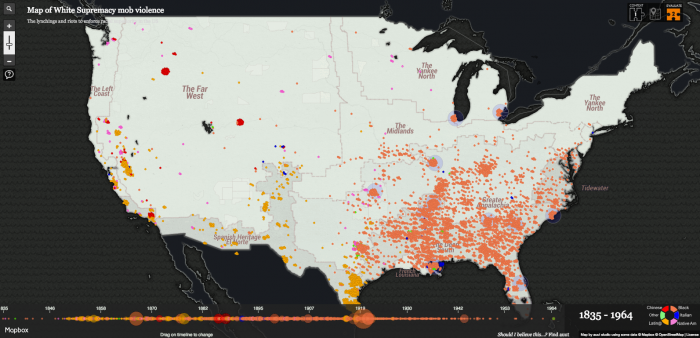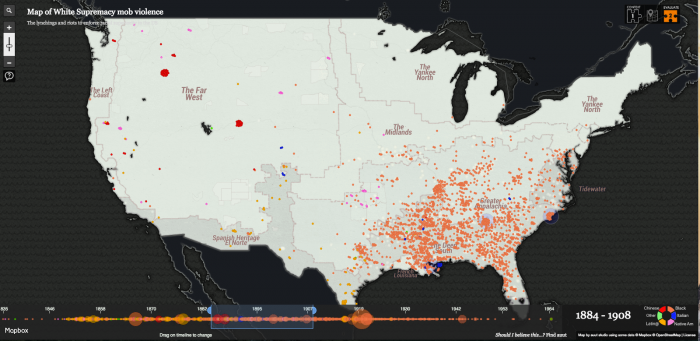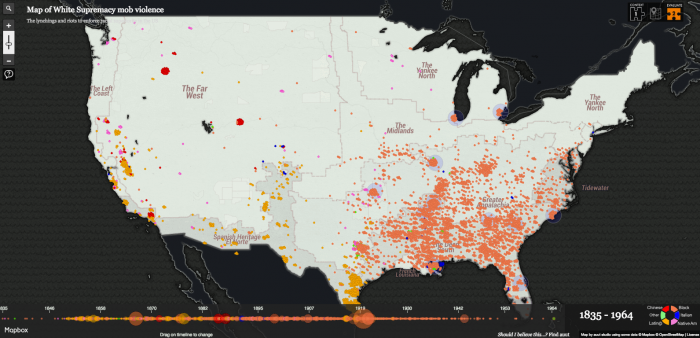
Whether we like to admit it or not, the history of the U.S. is in great degree a history of genocide and racist terror. As Roxanne Dunbar-Ortiz has demonstrated in An Indigenous Peoples’ History of the United States, the phrase “Manifest Destiny”—which we generally associate with the second half of the 19th century—accurately describes the nation’s ethos since well before its founding. The idea that the entire continent belonged by right of “Providence” to a highly specific group of European settlers is what we often hear spoken of now of as “white nationalism,” an ideology that has been as violent and bloody as certain other nationalisms, and in many ways much more so.
“Somehow,” writes Dunbar-Ortiz, “even ‘genocide’ seems an inadequate description for what happened” to the Native American nations. Martin Luther King, Jr. recognized this history as inseparable from the struggles of African-Americans and other groups, writing in 1963’s Why We Can’t Wait, “our nation was born in genocide when it embraced the doctrine that the original American, the Indian, was an inferior race. Even before there were large numbers of Negroes on our shores, the scar of racial hatred had already disfigured colonial society. From the sixteenth century forward, blood flowed in battles of racial supremacy.”
One striking commonality—or rather continuity—in the histories Dunbar-Ortiz and King tell is that a huge number of violent attacks on Native and Black people, slave and free, were carried out by ordinary settlers and citizens, unofficially deputized by the state as irregular enforcers of white supremacy. Especially in the century after the Civil War, white nationalism took the form of lynchings: brutal vigilante hangings, burnings, and mutilations meant to terrorize communities of color and enact the kind of frontier “justice” pioneered on the actual frontier. Most of the recorded victims were African-American, but “Native Americans, as well as Mexican, Chinese, and Italian workers were brutalized and murdered” as well, writes Laura Bliss at Citylab, and “although the rural South was by far the bloodiest region nationally, no area was really safe.”

Now, a new interactive map—named Monroe Work Today after the early 20th century historian (Monroe Nathan Work) who gathered much of the data—“aims to be the most comprehensive catalogue of proven lynchings that took place in the United States from 1835 to 1964.” The site calls its impressive map “a rebirth of one piece” of Monroe Work’s legacy, expanded to include many more sources and the post WWII period. “In the century after the Civil War,” write the map’s creators, “as many as 5000 people of color were executed—not by courts, but by mobs on the street who believed the cause of white supremacy.”
Lynchings became widespread in the early 1800s, “as a form of self-appointed justice in local communities… when townspeople made grave accusations first, but never bothered to gather proof.” In the postbellum U.S., such killings became more exclusively racialized in “very real crusades to change the United States to a place only for whites.” Local leaders “encouraged people to carry that idea onto the streets.” As you can see in the screenshots here from particularly violent periods in history, most, but by no means all of these extrajudicial killings took place in the South against African Americans.
In other areas of density in the Southwest, “Far West,” and “Left Coast” (as the project refers to these areas) the victims tended to be Latino/a, Chinese, or Native American. In New Orleans, a deep pool of blue marks the many Sicilian victims of lynching in the late 19th century.

For a number of reasons discussed on the site, the map’s creators caution against using their tool “to decide that some places suffered ‘more racism’ than others.” Many other forms of racist violence, from intimidation to rape, redlining, criminalization, and job discrimination have been widespread around the country and are not shown on the map. In anticipation of accusations of bias, Monroe Work Today encourages users to evaluate the source for themselves. (“You should always do this with anything you read online.”) A good place to start would be their extensive bibliography. As you scroll through the site, you’ll find other questions answered as well.
Writing at The Smithsonian, Danny Lewis calls the map “an important endeavor to help mark these dark parts of American history and make it more visible and accessible for all.” But Monroe Work Today is more than a research tool. The site bears witness to a continuing story. “The threat of violence for Americans of color is alive and real,” writes Bliss, “This is a good time to revisit its history.”
Related Content:
Visualizing Slavery: The Map Abraham Lincoln Spent Hours Studying During the Civil War
75 Years of CIA Maps Now Declassified & Made Available Online
Josh Jones is a writer and musician based in Durham, NC. Follow him at @jdmagness


It’s forgotten that just as many whites were lynched as any other demographic during that era. Back then, you behaved yourself (regardless of color)…or else. It must have worked, as evidenced by the stories that old people tell about how they used to be able to leave their front doors unlocked, and were able to sleep on the porch at night, etc. if they wanted to!
These studies and research are Interesting. Where can we see the data that supports the comment above?
As many Whites were lynched as Blacks during that era? Where is the evidence for that statement? I must be living in an alternative reality.
Take that white-nationalist revisionism somewhere else. Open Culture readers aren’t buying it.
From 1882–1968, 4,743 lynchings occurred in the United States. Of these people that were lynched 3,446 were black. The blacks lynched accounted for 72.7% of the people lynched. These numbers seem large, but it is known that not all of the lynchings were ever recorded. Out of the 4,743 people lynched only 1,297 white people were lynched.
http://www.naacp.org/history-of-lynchings/
Bill W., correlation does not imply causation. i think it is an insanely long stretch to condone lynching so that folks can leave their doors unlocked.
Bill W. this is as far back as I could find statistics, if you have further evidence please provide or retract your statement.
http://www.chesnuttarchive.org/classroom/lynching_table_year.html
p.s. i am of the opinion that no white man was ever lynched because of his skin color.
I call total BS on Bill W’s comment.